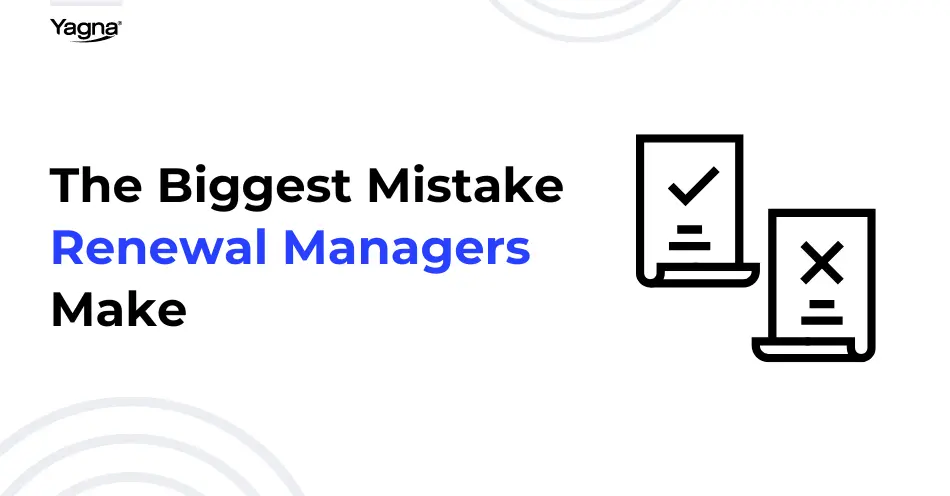
The Biggest Mistake Renewal Managers Make
Focusing Too Much on Transactions Over Relationships 💼➡️❤️
Did you know that one of the biggest pitfalls for renewal managers is focusing too much on the transactional aspects of renewals? It’s easy to get caught up in numbers, deadlines, and quotas. While securing recurring revenue is important, the most crucial element is often overlooked: building strong customer relationships.
The Transaction Trap
Many renewal managers fall into a routine of sending out emails, contracts, and setting deadlines, but they miss out on personalized communication. This leaves customers feeling like just another entry on a spreadsheet, which weakens their loyalty.
When customers feel their needs aren’t being prioritized, they’re more likely to explore other options. Even with a top-tier product or service, the lack of engagement can result in missed renewals and lost revenue.
Great renewal managers know that it’s not just about closing deals; it’s about growing relationships. Here’s how to steer clear of the transactional trap and foster stronger customer relationships.
The Relationship-Centered Approach
Renewal managers often concentrate primarily on the transactional aspects of renewals—closing deals, meeting quotas, and managing renewals as isolated events. While these elements are important, this narrow focus can undermine the broader goal of cultivating strong, enduring customer relationships.
Why This is a Problem:
- Customers Feel Like Just Another Account 📊: When renewal managers treat customers as mere entries on a spreadsheet, it creates a sense of depersonalization. Customers are more likely to feel undervalued and overlooked, which can damage trust and loyalty.
- Lack of Personalized Engagement 🎯: Without personalized interactions, renewal managers miss opportunities to address specific customer needs and preferences. This generic approach often results in missed renewals and lost revenue as customers seek more attentive service elsewhere.
Consequences of the Transactional Approach
The repercussions of focusing too much on transactions include:
- Decreased Customer Satisfaction 😞:When customers don’t feel valued, their satisfaction levels decline, making them less likely to renew.
- Reduced Revenue Growth 📉: Missed renewals and the inability to upsell or cross-sell to satisfied customers directly impact the bottom line.
3 Reasons Renewal Managers Should Rethink Their Approach
To avoid these pitfalls and drive better outcomes, renewal managers should adopt a relationship-centered approach. Here are three key strategies to help you transform your renewal process:
1. Segment Your Customers 🗂️
Identify Key Segments 🔍: Start by classifying your customers based on criteria such as industry, company size, and past interactions renewal risk potential. Segmentation allows you to understand the unique needs and potential of each group.
Tailor Communication 🎯: Customize your approach to align with each segment’s specific requirements and growth potential. For example, high-growth companies might benefit from more proactive engagement and additional services, while established clients might appreciate streamlined, efficient renewal processes. At risk customers may need more emphasis on the value they have been enjoying from the service.
Prioritize High-Value Accounts 💎: Focus more on customers with the greatest potential for growth and renewal. By allocating more time and resources to these high-value accounts, you can maximize your renewal rates and overall revenue.
2. Personalize Your Outreach 📝
Understand Their Pain Points 🔍: Take the time to research and identify the specific challenges your customers face. Understanding their pain points allows you to offer relevant solutions that demonstrate your commitment to their success.
Customize Messaging 💬: Craft personalized emails, calls, and meetings that address each customer’s unique needs and goals. Generic messages are easily ignored, but tailored communication shows that you value and understand the customer’s business.
Highlight Success Stories 🌟: Share relevant case studies or examples that resonate with their situation. Demonstrating how you’ve helped similar customers achieve their objectives can build trust and reinforce the value of renewing with your company.
3. Engage Regularly 🤝
Set Regular Check-ins 🗓️: Don’t wait until renewal time to reach out. Schedule consistent touchpoints throughout the year to maintain open lines of communication and stay top-of-mind.
Provide Value Continuously 💡: Offer insights, updates, or training sessions that demonstrate ongoing value. By consistently delivering value beyond the initial sale, you reinforce the benefits of your partnership.
Monitor Satisfaction 📈: Keep an eye on customer feedback and proactively address any concerns. Monitoring satisfaction levels helps you identify and resolve issues before they become reasons for non-renewal.
Strengthen Relationships, Boost Renewals
Renewals are the lifeblood of any recurring revenue, subscription-based business, but focusing solely on the transaction can lead to short-term gains at the expense of long-term success. By prioritizing relationships and adopting a proactive, customer-centric approach, you not only increase your chances of securing renewals but also build a loyal customer base that advocates for your brand.
We would love to share more strategies on how you can strengthen your customer relationships and boost your renewal rates. Connect and follow Yagna and explore how to make your renewals more than just a transaction: https://www.linkedin.com/company/yagnaiq